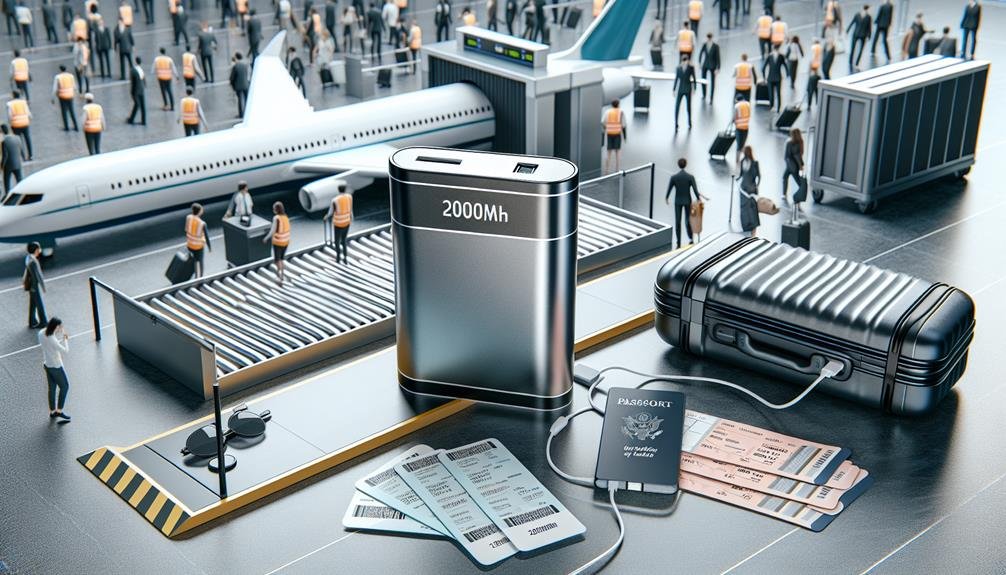Yes, you can bring a 20000mAh power bank on a flight, but it must go in your carry-on luggage. The capacity converts to approximately 74Wh, which is within the FAA's 100Wh limit for lithium-ion batteries. Make certain it's correctly packaged and labeled. Each airline might have specific rules, so double-check with them. Confirm it doesn't exceed the 100Wh limit to avoid needing special approval. Adhering to these guidelines enhances safety and prevents fines or confiscation. Understanding these details will ease your travel experience and guarantee compliance with all safety regulations.
Airline Regulations
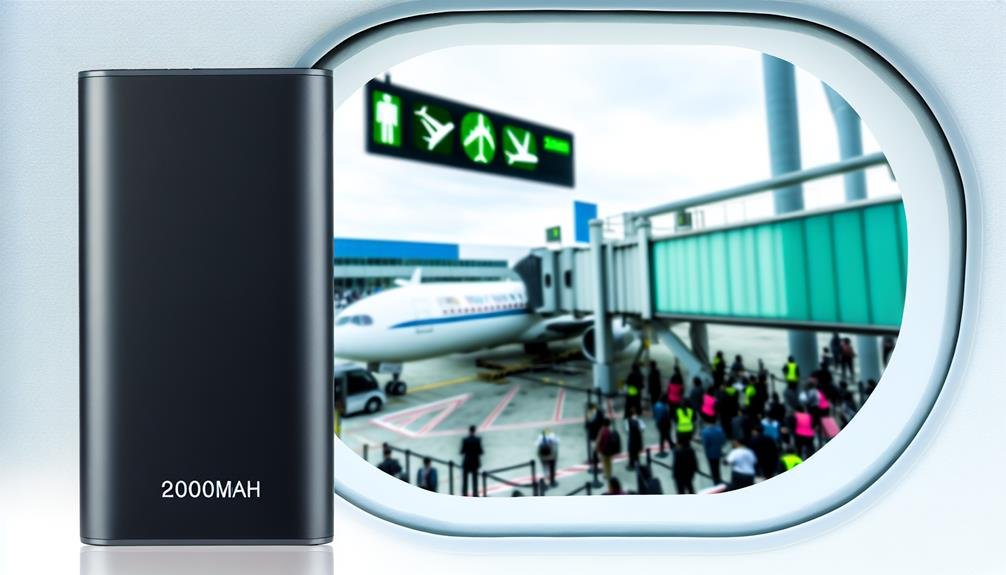
Understanding airline regulations for carrying a 20000mAh power bank is vital to guarantee compliance and avoid potential travel disruptions. Airlines impose specific power bank restrictions to secure the safety of passengers and crew. These devices are considered portable electronic equipment and must adhere to strict guidelines due to their lithium-ion batteries, which pose a fire risk if damaged or improperly handled.
Before packing your power bank, you need to be aware of in flight limitations. Most airlines require that power banks be carried in carry-on luggage only, as stowing them in checked baggage is typically prohibited. This rule minimizes the risk of fire in the aircraft's cargo hold, where detection and containment would be more challenging.
Furthermore, power banks must remain below certain watt-hour (Wh) limits, which are often set by aviation authorities like the FAA or EASA. While the 20000mAh capacity of your power bank might comply with these limits, it's essential to verify with your specific airline, as regulations can vary. Always check for any additional carrier-specific power bank restrictions to avoid confiscation or delays at security checkpoints. Securing compliance helps maintain safety and smooth travel experiences for everyone on board.
Power Bank Capacity Limits
When considering power bank capacity limits for air travel, calculating the watt-hour (Wh) rating is vital, as aviation authorities typically cap this at 100Wh for unrestricted carry-on use. To determine the Wh rating, multiply the power bank's capacity in milliampere-hours (mAh) by the voltage (usually 3.7V for lithium-ion batteries) and then divide by 1000. For example, a 20000mAh power bank would have a Wh rating of 74Wh, which falls safely within the 100Wh limit.
Here's a quick reference table:
| Capacity (mAh) | Voltage (V) | Wh Rating | Status |
|---|---|---|---|
| 10000 | 3.7 | 37Wh | Allowed |
| 20000 | 3.7 | 74Wh | Allowed |
| 27000 | 3.7 | 99.9Wh | Allowed |
| 30000 | 3.7 | 111Wh | Restricted |
Airlines impose these capacity limits to mitigate risks associated with lithium-ion batteries, which can pose fire hazards. It is important to adhere to these restrictions for your safety and others'. If your power bank exceeds 100Wh but is below 160Wh, some airlines may allow it with prior approval. Always check with your airline for their specific policies on power bank size and restrictions.
Lithium-Ion Battery Rules
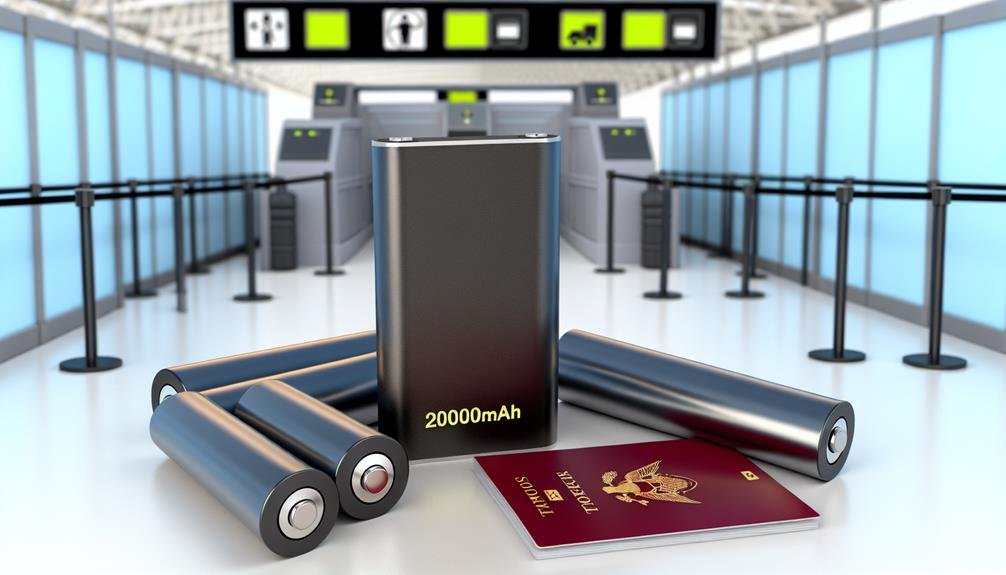
You need to be aware of specific regulations governing lithium-ion batteries when flying. Airlines typically permit power banks up to 100Wh (equivalent to 27000mAh at 3.7V) in carry-on luggage. Adherence guarantees safety and minimizes risks associated with battery malfunctions.
Capacity Limits Explained
The Federal Aviation Administration (FAA) imposes strict guidelines on lithium-ion battery capacity allowed on flights to mitigate fire risks and guarantee passenger safety. When planning your travel, it's important to understand these travel restrictions, as non-compliance can result in confiscation or fines. Specifically, the FAA sets a maximum battery capacity limit for lithium-ion batteries at 100 watt-hours (Wh) per battery for general carry-on without requiring airline approval.
To break it down, a 20000mAh power bank typically translates to around 74Wh, well within the FAA's allowable limit. However, if your power bank exceeds 100Wh but is less than 160Wh, you can still bring it onboard, but you'll need airline approval. Anything over 160Wh is strictly prohibited in both carry-on and checked luggage due to the significant fire risk it poses.
These regulations aim to minimize potential hazards associated with lithium-ion batteries, such as overheating or short-circuiting, which could lead to fires. By adhering to these guidelines, you help ensure a safer environment for everyone on board. Always check your power bank's specifications and consult with your airline if there's any uncertainty regarding compliance with FAA rules.
Carry-on Regulations
Carry-on regulations for lithium-ion batteries are strict to mitigate risks of fire hazards and guarantee passenger safety. When traveling with a 20000mAh power bank, you must adhere to specific guidelines to guarantee compliance and safety. The most critical aspect is the power bank storage in your carry-on luggage. Airlines typically prohibit these devices in checked baggage due to the potential fire risk.
To assist you in understanding these regulations, here's a helpful table:
| Aspect | Regulation | Details |
|---|---|---|
| Capacity | Must not exceed 100Wh | 20000mAh typically equals 74Wh |
| Power Bank Storage | Must be in carry-on luggage | Prohibited in checked baggage |
| Voltage Restrictions | Ensure proper voltage rating | Generally, 3.7V to 4.2V per cell |
| Approval | Required for devices over 100Wh | Contact airline for special permissions |
| Labeling | Must indicate capacity and voltage | Clear and visible labeling is mandatory |
Carry-On Vs. Checked Luggage
When deciding whether to pack your 20000mAh power bank in carry-on or checked luggage, consider that most airlines and regulatory bodies mandate it be carried in the cabin due to safety regulations concerning lithium-ion batteries. These batteries are prone to overheating, which poses a fire risk. Therefore, keeping them in the cabin allows for immediate action in case of an emergency.
Cabin restrictions and baggage limitations are vital in this situation. Airlines typically allow power banks up to a certain watt-hour (Wh) rating in carry-on luggage, and your 20000mAh power bank usually falls within permissible limits. Make sure it's easily accessible for security screening, as power banks are often among the prohibited items in checked luggage.
Security screening processes are strict about lithium-ion batteries. They must be kept in carry-on bags where they can be closely monitored. Stowing them in checked baggage increases the risk since there's limited access during flight.
It's necessary to be aware of each airline's specific regulations to comply fully. By following these guidelines, you reduce potential hazards and ensure a safer flying experience for everyone onboard.
International Travel Guidelines
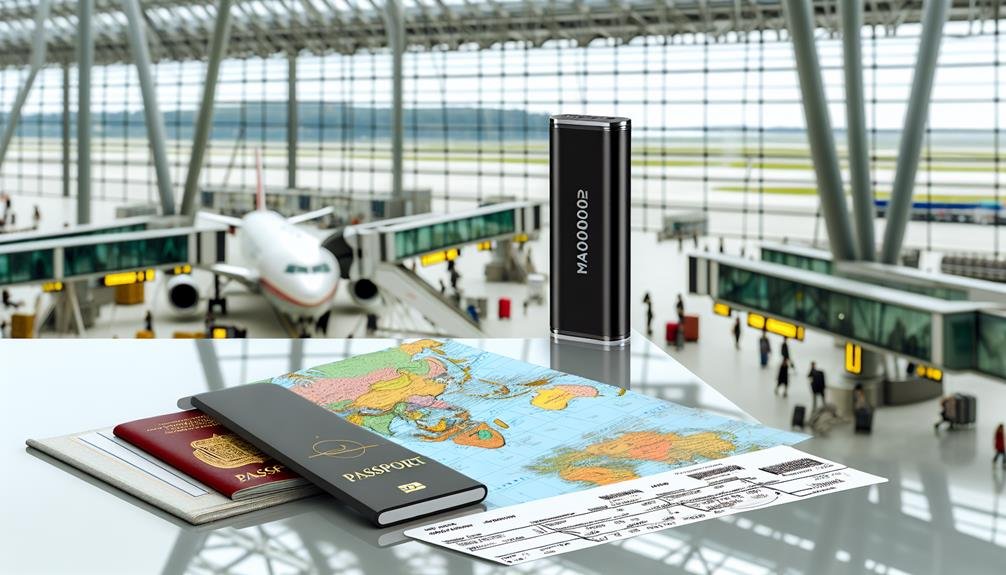
When preparing for international travel, you must adhere to airline battery regulations and understand the difference between carry-on and checked luggage rules. Different countries may have specific restrictions on battery capacity and placement, potentially impacting your compliance. Always verify with your airline and destination country to mitigate risks of non-conformity and guarantee a smooth journey.
Airline Battery Regulations
Understanding airline battery regulations is essential for international travel to guarantee compliance with safety standards and avoid potential risks. When it comes to bringing a 20000mAh power bank on your flight, you need to be aware of the specific guidelines that airlines enforce.
Firstly, battery size is a crucial factor. The International Air Transport Association (IATA) typically allows lithium-ion batteries with a capacity up to 100 watt-hours (Wh) without special permission. Since 20000mAh equals approximately 74Wh, your power bank generally falls within acceptable limits.
However, there are flight restrictions to keep in mind:
- Airline Policies: Each airline might have its own specific rules. Always check with your carrier before traveling.
- Quantity Limits: You may be restricted to carrying a maximum number of batteries, often two, if they exceed 100Wh but are under 160Wh.
- Packaging: Batteries should be carried in their original packaging or insulated to prevent short circuits.
- Approval Requirements: For batteries exceeding 100Wh, airlines might require prior approval.
Adhering to these regulations minimizes risks such as fire hazards and ensures a safer flying experience for everyone. Always stay informed and prepared about these rules to guarantee a hassle-free travel.
Carry-On Vs. Checked
It's important to know whether your 20000mAh power bank should be in your carry-on or checked luggage to meet international travel guidelines and comply with safety regulations. Generally, most airlines mandate that power banks, including those rated at 20000mAh, must be carried in your carry-on baggage. This is due to the potential fire hazard lithium-ion batteries pose, which is more easily managed in the cabin.
When considering size restrictions and weight limits, note that power banks with a capacity of 100Wh or less (approximately 27000mAh) are usually allowed without special permission. Your 20000mAh power bank typically falls well within this range. However, always verify the specific watt-hour rating on your device to ensure compliance.
Placing power banks in checked baggage is generally prohibited because it increases the risk of a fire in an area that is not easily accessible during flight. Cabin storage allows crew members to quickly address any overheating or fire incidents, thereby enhancing passenger safety.
Ultimately, adhering to these guidelines not only ensures compliance with airline regulations but also reduces the risk associated with lithium-ion batteries during air travel. Always double-check with your airline for any additional requirements or updates to their policies.
Specific Country Restrictions
Different countries impose varying restrictions on the transport of 20000mAh power banks, making it essential to familiarize yourself with specific regulations for each destination. Understanding these power bank restrictions guarantees compliance with international travel restrictions and enhances your safety.
When traveling internationally, consider the following:
- United States: The TSA permits power banks with a capacity of up to 100Wh (approximately 27000mAh) in carry-on luggage. However, they must not be in checked baggage.
- European Union: The EU follows similar guidelines to the U.S., allowing power banks up to 100Wh in carry-on bags only. Always check with specific airlines as they might have more stringent rules.
- China: China's regulations are stricter. Power banks under 100Wh are allowed in carry-on baggage, but those between 100Wh and 160Wh require airline approval. Anything above 160Wh is prohibited.
- Australia: The Civil Aviation Safety Authority (CASA) permits power banks up to 100Wh without prior approval. For those between 100Wh and 160Wh, approval is necessary, and they must be carried in the cabin.
Safety Precautions
Always verify your 20000mAh power bank complies with airline regulations and is placed in your carry-on luggage to lessen risks associated with overheating or battery failure. Adhering to safety measures is important to guarantee a safe journey. Begin by checking the specific watt-hour (Wh) rating of your power bank; typically, a 20000mAh power bank with a voltage of 3.7V has a capacity of 74Wh, which is generally permissible on flights.
Adopt travel tips such as utilizing a protective case to prevent physical damage and avoiding exposure to extreme temperatures. When passing through airport security, be prepared to demonstrate that your power bank meets battery safety standards, and make sure it is easily accessible for inspection.
In addition, avoid using or charging the power bank during takeoff and landing, as this can pose a fire hazard. Regularly inspect your power bank for any signs of swelling, leakage, or damage, and discontinue use immediately if any are found. By following these guidelines, you can greatly reduce potential risks and guarantee that your travel experience remains safe and compliant with regulations.
Preparing for Security Checks
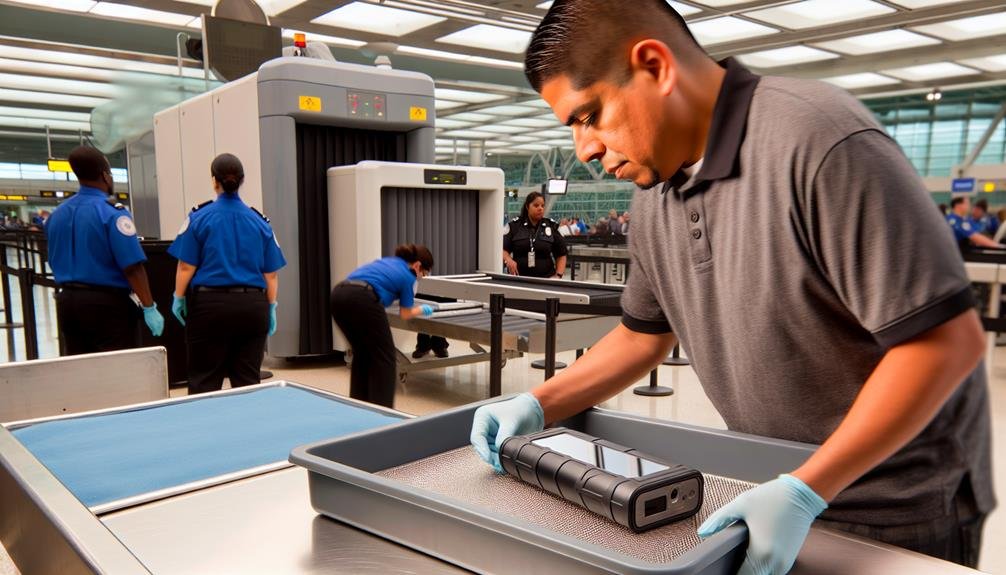
Make sure your 20000mAh power bank is easily accessible and properly labeled for a smooth security check process at the airport. Proper preparation can greatly reduce delays and ensure compliance with airline regulations.
Here are some packing tips and security measures to keep in mind:
- Label Visibility: Be certain the power bank's capacity (mAh) is clearly printed and visible. This helps security personnel quickly verify its compliance with airline regulations.
- Carry-On Placement: Always pack your power bank in your carry-on luggage. Most airlines prohibit power banks in checked luggage due to the risk of overheating and potential fire hazards.
- Protective Packaging: Use a protective case to prevent any damage. Make sure the power bank has no exposed terminals to avoid accidental short circuits.
- Follow Airline-Specific Guidelines: Different airlines might have specific rules regarding the transport of battery packs. Check your airline's website for any additional requirements before traveling.
Recommended Power Banks
After ensuring your power bank meets airline regulations, it's important to consider dependable models that offer both safety and performance. When selecting a power bank, prioritize those with certified safety features, including overcharge protection, short circuit protection, and temperature control. Not all power bank sizes are created equal; understanding your travel essentials is essential.
For instance, Anker PowerCore 20100mAh is a popular choice due to its robust safety measures and high capacity. Another reliable option is the RAVPower 20000mAh, which boasts advanced safety mechanisms and an ergonomic design. Both models comply with the standard 100Wh limit imposed by most airlines, minimizing the risk of non-compliance and ensuring a smooth travel experience.
Additionally, consider models like Zendure A3PD 10000mAh if you're looking for a smaller power bank size that still meets your travel essentials. This model offers rapid charging and multiple safety protocols, making it a great choice for shorter trips.
Frequently Asked Questions
Can I Use My Power Bank During the Flight?
When it comes to using your power bank during the flight, it's a double-edged sword. You can use it for charging devices, but make certain the battery capacity complies with airline regulations to guarantee safety.
What Should I Do if My Power Bank Overheats?
If your power bank overheats, prioritize power bank safety. Immediately unplug it, place it in a cool, well-ventilated area, and monitor for any signs of damage. Effective heat management decreases the risk of fire or explosion.
Are There Any Restrictions on Specific Power Bank Brands?
Yes, there are restrictions on specific power bank brands. Always check the airline regulations regarding power bank sizes, as some airlines might have specific bans based on brand reputation and safety records to guarantee passenger safety.
How Do I Check My Power Bank's Watt-Hour Rating?
Think of your power bank as a suitcase; you'll need to check its watt-hour rating to guarantee it meets airline regulations. Multiply its voltage by its capacity (mAh) to confirm it's within the watt-hour limit for international flights.
Can I Bring Multiple Power Banks on a Flight?
Yes, you can bring multiple power banks on a flight, but make sure their battery capacity complies with airline regulations. Check in-flight restrictions, as exceeding limits could pose risks for charging devices and overall safety.

